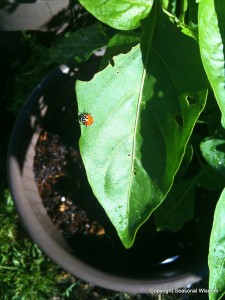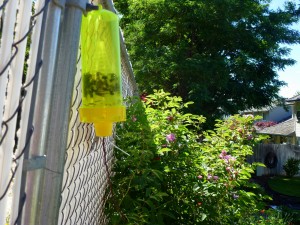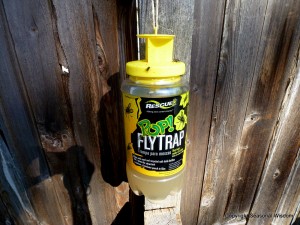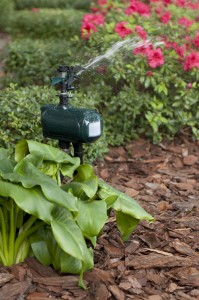
It’s only natural to discover insects and animals of all types in a healthy garden. For instance, bees are very important pollinators who deserve the welcome mat to your flowers and plants. This particular one is enjoying my garden poppies, as you can see.
But what about those annoying pests like deer, flies and yellowjackets? How can you control those pests in an earth-friendly manner? Here are a couple ideas to consider…
There are insects that are easy to love — such as ladybugs, which can eat up to 1,000 aphids in their lifetimes. Yep, you read that right. These bugs are amazing.
And then there are the bugs that aren’t so easy to love, such as annoying flies, stinging wasps and gophers or deer that can gobble up your garden the minute you turn around.
This post offers a few non-toxic options for fighting those pests, based on some product tests that Seasonal Wisdom just completed with Rescue!® and Havahart®.
First, let’s look at yellowjackets. With a mild winter last year, these stinging insects were flying around like nuts earlier this summer, as the temperatures reached over 70 degrees.
Just one queen can build a nest with up to 5,000 worker bees in late summer or early fall. So, obviously, controlling those wasps was my top concern this growing season.
Unlike peaceful and beneficial honeybees, these yellowjackets can be aggressive and life threatening, in some cases. That’s why I liked the idea of the Rescue reusable Yellowjacket Trap, which uses a scientifically formulated attractant to trap the queen and her workers into a chamber so they can’t escape. It doesn’t apply dangerous poisons, but instead makes the yellowjackets dehydrate and die inside the trap.
Although the wasps can get inside the trap, beneficial honeybees and native bees can’t. I hung my trap away from most of my garden beds, and I couldn’t believe how many yellowjackets I attracted in just a few days. Here is a photo early in the season. The trap is now filled, and I would show you a photo — but it looks pretty gross.
Another annoying insect is the fly — whether it’s a house fly, cluster fly, blow fly or secondary screwworm fly, they all are annoying. And they spread diseases. Flies are carriers of filth and more than 60 human and animal diseases, including salmonellosis, E. coli and tuberculosis, according to Sterling International, Inc., makers of the Rescue products.
Not only that, flies breed quickly. They can lay clusters of 75 to 100 eggs within 24 hours. Pretty creepy, huh?
So, I stuck my Rescue Pop! Fly Trap over by the dog run, not far from my compost piles. Not surprisingly, we get lots of flies hovering over in that area of the garden. The trap also uses a fast-acting attractant that’s safe, non-toxic and sanitary. That was important to me. I may not like flies, but I don’t want to spray a lot of poisons around my garden to control them.
The reusable traps are made from recycled, 2-liter soda pop bottles that can catch up to 20,000 flies. I was particularly impressed to learn that these bottles are collected from the community to encourage recycling and waste reduction.
The company has collected more than 10,000 pop bottles from local scout troops, churches, youth groups and school classrooms. For each bottle donated, the company gives 10 cents each. It’s keeping those bottles out of our landfills, and any bottles not collected from the community are manufactured from post-consumer plastic.
I’ve been very pleased at this trap. Since this time, the Pop! Fly Trap is filling up quickly with dead flies, which looks rather disgusting so I decided not to show you that photo either. You’ll have to take my word for it!
Do you have problems with deer, squirrels or gophers attacking your garden? How about neighborhood cats that dig up your just-seeded vegetable beds? The Havahart Spray Away is a humane way to control these pests. It features a motion activated animal repellent that sprays water to chase them away.
Use this repellent system to keep your garden beds save from these critters, without having to install electric fences. Particularly, if you live out in deer-prone areas, you may want to give this one a try.
Meanwhile, here’s more information about good bugs and bad bugs from Texas A&M University Extension. It was written for kids, but there is plenty of helpful advice for us “big kids” too.
For those of you in deer country, here’s a list of landscape plants rated by Rutgers University on their deer resistance.
Disclosure: As a garden writer, I was provided with these products at no charge for a product test.
Which pests caused the biggest problems for you this summer? How do you like to control them?
















{ 4 comments }
I have this terrible moth that eats the green from my garden herbs– leaving the leaves spotted and worn. I wish I knew what to do about them!
Hi: I suggest you contact your local master gardeners, and describe the moth completely. If you can catch one, put it in a plastic bag to show them. Master Gardeners will provide free science-based advice to help you safely control this insect. To find a Master Gardener near you – http://www.ahs.org/master_gardeners/ – Good luck, and thanks for visiting Seasonal Wisdom. Teresa
We have so many deer you can’t even imagine. They sleep under the London Plane tree by our side deck. Nothing keeps them away so we have learned to live with them. We never plant anyting that they normally might like which helps a lot. Life is easier this way.
Thanks for sharing your story. Your decision to co-exist with the deer sounds like a wise one. I bet it looks very pretty, however, with all the deer. At least that is a very nice trade off for you. Teresa
Comments on this entry are closed.